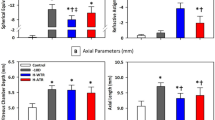Abstract
THE aetiology of myopia has been studied mainly by investigating the distribution of refractive errors in human populations1. No clear conclusion has emerged, however, so the prevailing clinical attitude is that myopia can neither be prevented nor cured, but only corrected with appropriate lenses. The mechanism of myopia can be rationally analysed only if a suitable animal model is found for this refractive condition. In the literature, there are only two examples of experimental myopia. Levinsohn2 claimed that a high degree of myopia develops in young monkeys when the body is kept elevated above the head for long periods of time; his results, however, have been questioned3,4. Young5 induced myopia by exposing monkeys to a restricted visual space, but the refractive error thus obtained was relatively small. During investigations on monocular visual deprivation in monkeys6 it was noted that the eye in which the lids had been closed by suture at birth developed a high degree of myopia. We report here a study of the effects of neonatal lid fusion on the refractive state and anatomy of the macaque monkey eye.
This is a preview of subscription content, access via your institution
Access options
Subscribe to this journal
Receive 51 print issues and online access
$199.00 per year
only $3.90 per issue
Buy this article
- Purchase on Springer Link
- Instant access to full article PDF
Prices may be subject to local taxes which are calculated during checkout
Similar content being viewed by others
References
Duke-Elder, W. S. Text-book of Ophthalmology 5 (Kimpton, London, 1970).
Levinsohn, G. Die Entstehung der Kurzsichtigkeit (Karger, Berlin, 1912); Klin Mbl. Augenheilk. 62, 794–803 (1919); Arch. Augenheilk. 100, 138–163 (1929).
Behr, C. Klin. Mbl. Augenheilk. 62, 412–429 (1919).
Marchesani, O. Arch. Augenheilk. 104, 177–191 (1931).
Young, F. A. Am. J. Ophthalm. 52, 799–806 (1961); Am. J. Optom. Archs Am. Acad. Optom. 38, 545–555 (1961); ibid. 39, 60–67 (1962); ibid. 42, 439–449 (1965); Invest. Ophthalm. 2, 571–577 (1963).
Hubel, D. H., Wiesel, T. N. & LeVay, S., Cold Spring Harbor Svmp. quant. Biol. 40, 581–589 (1975).
Wiesel, T. N. & Raviola, E. Meeting, Association for Research in Vision and Ophthalmology (ARVO, Sarasota, Florida, p. 96, May 1975).
Author information
Authors and Affiliations
Rights and permissions
About this article
Cite this article
WIESEL, T., RAVIOLA, E. Myopia and eye enlargement after neonatal lid fusion in monkeys. Nature 266, 66–68 (1977). https://doi.org/10.1038/266066a0
Received:
Accepted:
Published:
Issue Date:
DOI: https://doi.org/10.1038/266066a0
This article is cited by
-
The role of vasoactive intestinal peptide (VIP) in atropine-related inhibition of the progression of myopia
BMC Ophthalmology (2024)
-
Models of myopia: the effect of accommodation, lenses and atropine
Eye (2023)
-
Retinal VIP-amacrine cells: their development, structure, and function
Eye (2023)
-
Comparison of baseline biometry measures in eyes with pediatric cataract to age-matched controls
Graefe's Archive for Clinical and Experimental Ophthalmology (2023)
-
Genome-wide analysis of retinal transcriptome reveals common genetic network underlying perception of contrast and optical defocus detection
BMC Medical Genomics (2021)
Comments
By submitting a comment you agree to abide by our Terms and Community Guidelines. If you find something abusive or that does not comply with our terms or guidelines please flag it as inappropriate.



